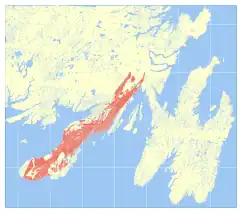| Marystown Group | |
|---|---|
| Stratigraphic range: | |
| Type | Group |
| Underlies | Rencontre Formation (sometimes classified in Long Harbour Group) |
| Overlies | Burin Group (unconformably), Rock Harbour Group[1] |
| Location | |
| Region | |
| Country | |
 Occurrence of Marystown Group in southeastern Newfoundland | |
The Marystown Group is a Neoproterozoic stratigraphic group of predominantly volcanic sediments – subaerially deposited ash flow tuffs from rhyolites and alkali basalts[2] (with some minor sedimentary strata – red to green siltstones to conglomerates[2] – interleaved), with a central sandstone unit, cropping out in Newfoundland.[1]
It is likely to be temporally equivalent (more or less) to the Love Cove Group, Connaigre Bay Group, Long Harbour Group and Rock Harbour Group.[1]
Age
More accurate/precise dates suggest that the formation is 580-570 Ma (younger than stated in the box above, which uses U-Pb dates).[3]
References
- 1 2 3 4 Myrow, P (1995). "Neoproterozoic rocks of the Newfoundland Avalon Zone". Precambrian Research. 73 (1–4): 123–136. Bibcode:1995PreR...73..123M. doi:10.1016/0301-9268(94)00074-2.
- 1 2 Strong, D. F.; O'Brien, S. J.; Taylor, S. W.; Strong, P. G.; Wilton, D. H. (1978). "Aborted Proterozoic rifting in eastern Newfoundland". Canadian Journal of Earth Sciences. 15 (1): 117–131. Bibcode:1978CaJES..15..117S. doi:10.1139/e78-010.
- ↑ McNamara, Allen K.; Niocaill, Conall Mac; Van Der Pluijm, Ben A.; Der Voo, Rob Van (2001). "West African proximity of the Avalon terrane in the latest Precambrian". Geological Society of America Bulletin. 113 (9): 1161. Bibcode:2001GSAB..113.1161M. doi:10.1130/0016-7606(2001)113<1161:WAPOTA>2.0.CO;2.
This article is issued from Wikipedia. The text is licensed under Creative Commons - Attribution - Sharealike. Additional terms may apply for the media files.